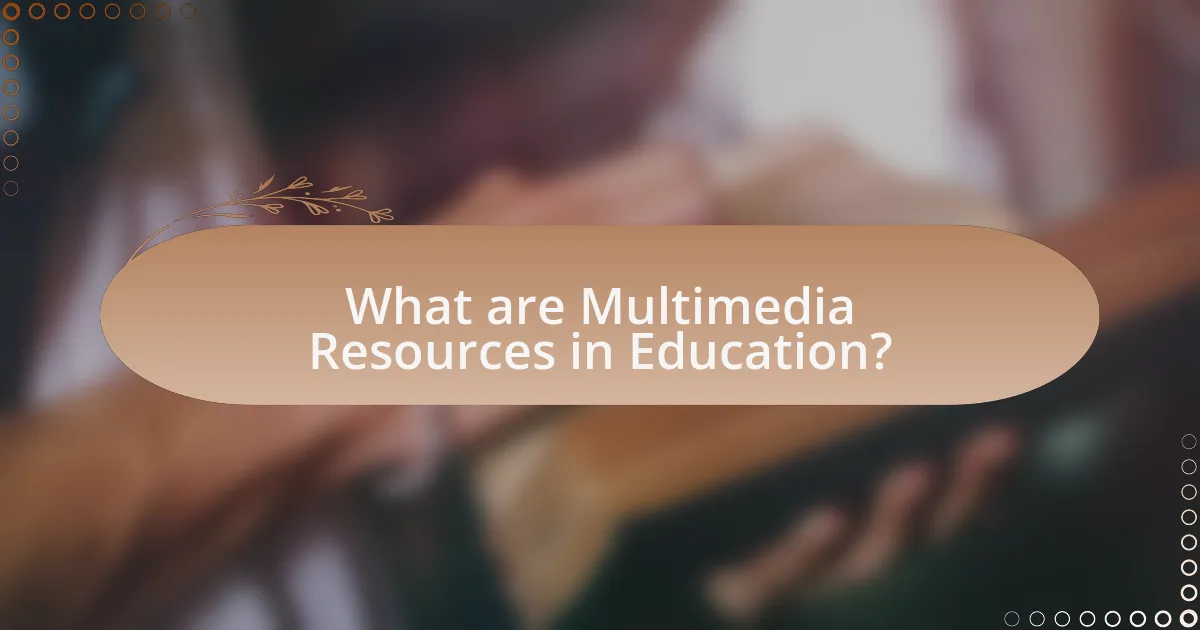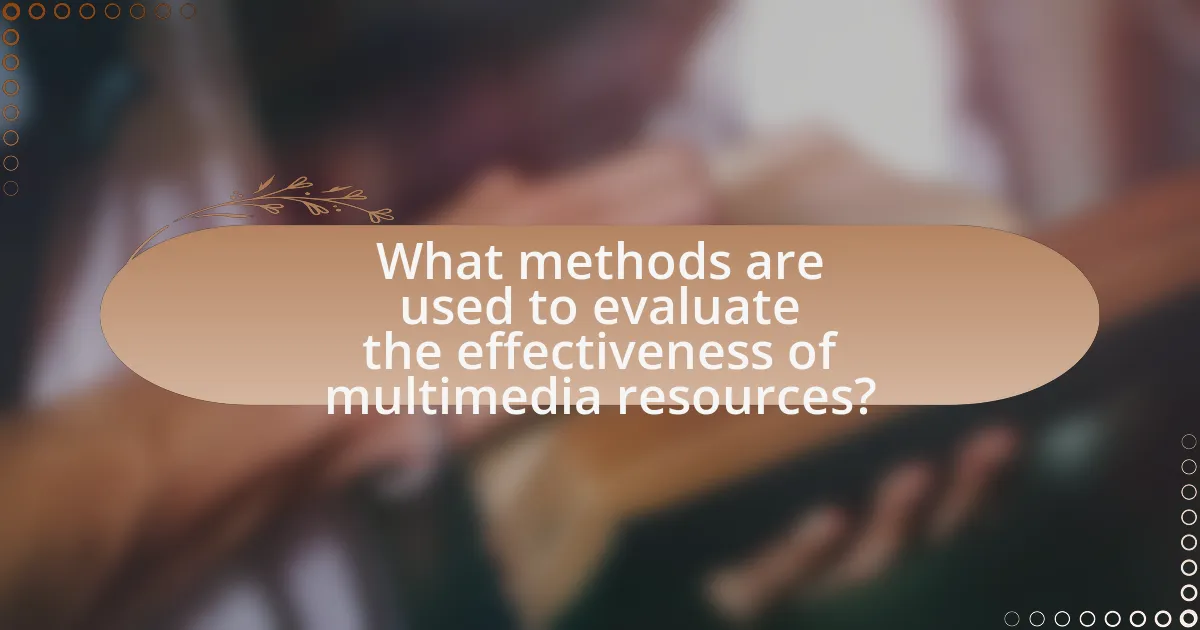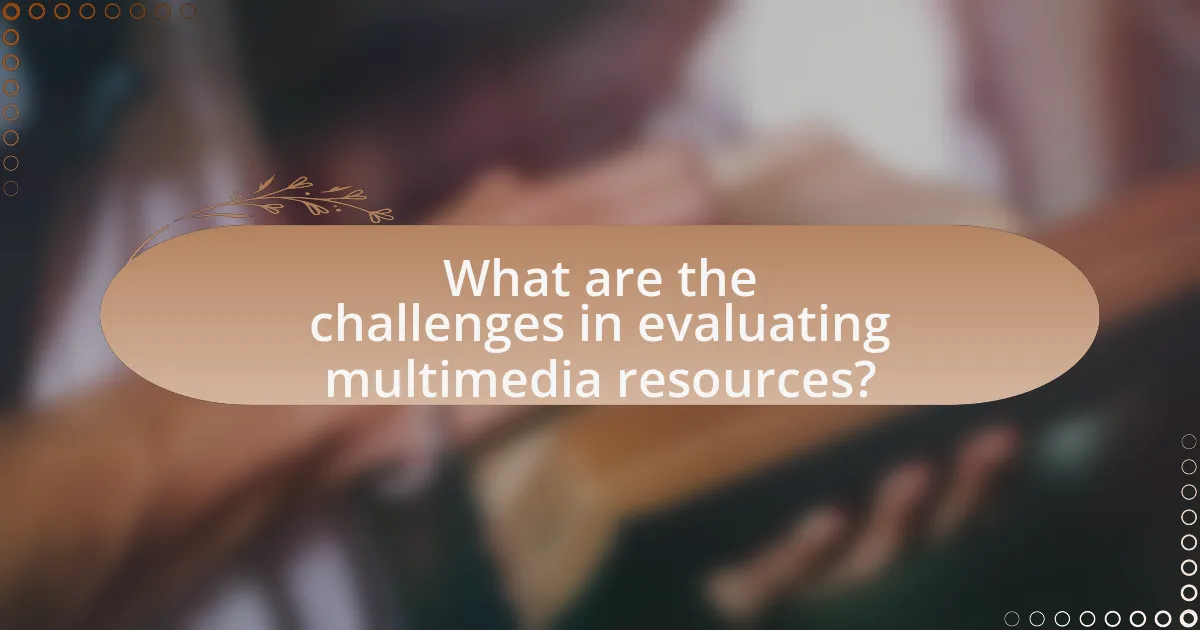The article focuses on evaluating the effectiveness of multimedia resources in education, which are tools that integrate text, audio, images, animations, and video to enhance learning experiences. It discusses how these resources cater to diverse learning styles, improve student engagement, and lead to better retention of information. Key topics include the types of multimedia commonly used, the importance of evaluating their effectiveness, and the criteria and methods for assessment, including both qualitative and quantitative approaches. Additionally, the article addresses challenges in evaluation, the impact of technological advancements, and best practices for educators to ensure high-quality multimedia resources are utilized effectively in educational settings.

What are Multimedia Resources in Education?
Multimedia resources in education are tools that combine various forms of content, such as text, audio, images, animations, and video, to enhance the learning experience. These resources facilitate diverse learning styles and improve engagement by providing interactive and dynamic content. Research indicates that the use of multimedia in educational settings can lead to better retention of information and increased motivation among students, as evidenced by studies showing that students exposed to multimedia presentations perform better on assessments compared to those who receive traditional instruction.
How do multimedia resources enhance the learning experience?
Multimedia resources enhance the learning experience by engaging multiple senses, which facilitates better retention and understanding of information. Research indicates that learners who use multimedia tools, such as videos, interactive simulations, and audio-visual presentations, demonstrate improved comprehension and recall compared to those who rely solely on traditional text-based materials. For instance, a study published in the Journal of Educational Psychology found that students exposed to multimedia instruction scored 30% higher on retention tests than those who received conventional instruction. This effectiveness stems from the ability of multimedia to cater to diverse learning styles, making education more accessible and effective for a wider range of students.
What types of multimedia resources are commonly used in education?
Commonly used multimedia resources in education include videos, interactive simulations, podcasts, and digital presentations. Videos enhance learning by providing visual and auditory content, making complex concepts easier to understand. Interactive simulations allow students to engage with material in a hands-on manner, fostering experiential learning. Podcasts offer auditory learning opportunities, catering to different learning styles. Digital presentations, such as slideshows, facilitate organized information delivery and can incorporate various media types. These resources are effective in improving student engagement and comprehension, as supported by studies showing that multimedia learning can enhance retention and understanding of educational content.
How do different multimedia formats impact student engagement?
Different multimedia formats significantly enhance student engagement by catering to diverse learning styles and preferences. Research indicates that incorporating videos, interactive simulations, and audio elements can increase retention rates and motivation among students. For instance, a study by Mayer (2009) found that students who learned through multimedia presentations scored higher on retention tests compared to those who received traditional text-based instruction. Additionally, interactive formats, such as gamified learning experiences, have been shown to foster active participation, leading to deeper understanding and engagement. Thus, the use of varied multimedia formats effectively supports and boosts student engagement in educational settings.
Why is it important to evaluate multimedia resources?
Evaluating multimedia resources is important because it ensures the quality and relevance of educational content. High-quality multimedia resources enhance learning by engaging students and facilitating better understanding of complex concepts. Research indicates that effective multimedia can improve retention rates by up to 50% compared to traditional methods, as shown in studies conducted by the University of California, which highlight the positive impact of interactive elements on student engagement and comprehension. Therefore, evaluating these resources is crucial for maximizing educational outcomes.
What criteria should be used for evaluating multimedia effectiveness?
The criteria for evaluating multimedia effectiveness include engagement, clarity, educational value, accessibility, and technical quality. Engagement measures how well the multimedia captures and maintains the audience’s attention, which is crucial for effective learning. Clarity assesses whether the content is presented in a straightforward manner, facilitating understanding. Educational value evaluates the extent to which the multimedia enhances learning outcomes, supported by studies showing that interactive elements can improve retention rates. Accessibility ensures that all learners, including those with disabilities, can access the content, aligning with universal design principles. Technical quality examines the production standards, including audio-visual clarity and functionality, which impact user experience. These criteria collectively provide a comprehensive framework for assessing multimedia resources in educational contexts.
How does the evaluation process differ for various educational levels?
The evaluation process differs for various educational levels primarily in complexity and focus. At the elementary level, evaluations often emphasize basic skills and knowledge acquisition through formative assessments, such as quizzes and observational assessments, to gauge understanding and engagement. In contrast, middle school evaluations begin to incorporate more standardized testing and project-based assessments that assess critical thinking and application of knowledge. At the high school level, evaluations shift towards summative assessments, including final exams and standardized tests, which measure comprehensive understanding and readiness for post-secondary education or vocational training. Research indicates that these differences are essential for aligning assessment methods with developmental stages and learning objectives, ensuring that evaluations are appropriate for the cognitive and emotional maturity of students at each level.

What methods are used to evaluate the effectiveness of multimedia resources?
Methods used to evaluate the effectiveness of multimedia resources include formative assessments, summative assessments, user feedback, and performance metrics. Formative assessments, such as quizzes and interactive activities, provide real-time insights into learner engagement and comprehension. Summative assessments, like final exams or projects, measure overall learning outcomes after multimedia resource usage. User feedback, collected through surveys and interviews, offers qualitative data on user experience and perceived value. Performance metrics, including completion rates and time spent on tasks, quantitatively assess how effectively multimedia resources facilitate learning. These methods collectively ensure a comprehensive evaluation of multimedia resources in educational settings.
How can qualitative and quantitative methods be applied in evaluations?
Qualitative and quantitative methods can be applied in evaluations by providing complementary insights into the effectiveness of multimedia resources in education. Qualitative methods, such as interviews and focus groups, allow evaluators to gather in-depth feedback from students and educators about their experiences and perceptions of multimedia resources. This approach can reveal nuanced insights into how these resources impact learning engagement and comprehension. Quantitative methods, including surveys and standardized tests, enable evaluators to collect measurable data on student performance and engagement levels, allowing for statistical analysis of the effectiveness of multimedia resources. For instance, a study might show that students using multimedia resources scored 15% higher on assessments compared to those using traditional materials, demonstrating the potential impact of these resources on educational outcomes.
What are the advantages of using qualitative methods in multimedia evaluation?
Qualitative methods in multimedia evaluation provide in-depth insights into user experiences and perceptions, which are crucial for understanding the effectiveness of educational resources. These methods, such as interviews and focus groups, allow evaluators to gather rich, contextual data that quantitative methods may overlook. For instance, qualitative evaluations can reveal how multimedia resources impact engagement and learning outcomes by capturing nuanced feedback from users. This approach has been supported by studies indicating that qualitative data can enhance the understanding of user interactions and satisfaction, ultimately leading to more effective multimedia design and implementation in educational settings.
How do quantitative methods provide measurable outcomes?
Quantitative methods provide measurable outcomes by utilizing numerical data to assess and analyze educational effectiveness. These methods employ statistical techniques to quantify variables, allowing for objective comparisons and evaluations of multimedia resources in educational settings. For instance, standardized test scores can be analyzed to determine the impact of specific multimedia tools on student learning outcomes, providing concrete evidence of their effectiveness. Additionally, surveys with Likert scale responses can yield quantifiable insights into student engagement and satisfaction, further supporting the assessment of multimedia resources.
What role do surveys and feedback play in the evaluation process?
Surveys and feedback are critical components in the evaluation process as they provide direct insights from users regarding their experiences and perceptions. These tools enable educators and researchers to gather quantitative and qualitative data, which can be analyzed to assess the effectiveness of multimedia resources in education. For instance, a study published in the “Journal of Educational Technology & Society” found that feedback collected through surveys significantly improved the understanding of student engagement and learning outcomes, demonstrating the value of user input in refining educational tools.
How can student feedback be effectively gathered and analyzed?
Student feedback can be effectively gathered and analyzed through structured surveys and focus groups. Structured surveys, utilizing Likert scales and open-ended questions, allow for quantitative and qualitative data collection, enabling educators to assess student perceptions of multimedia resources. Focus groups provide deeper insights into student experiences and preferences, facilitating a richer understanding of feedback. Research indicates that combining these methods enhances the reliability of feedback; for instance, a study by Hattie and Timperley (2007) in “Review of Educational Research” emphasizes the importance of feedback in improving educational outcomes. This dual approach ensures comprehensive data collection, leading to informed decisions regarding multimedia resource effectiveness.
What are the limitations of relying solely on surveys for evaluation?
Relying solely on surveys for evaluation has significant limitations, including potential bias, lack of depth, and limited context. Surveys often suffer from response bias, where participants may provide socially desirable answers rather than their true opinions, leading to inaccurate data. Additionally, surveys typically offer quantitative data that may not capture the nuances of participants’ experiences or the complexities of multimedia resource effectiveness in education. For instance, a study by the American Educational Research Association found that qualitative methods, such as interviews or focus groups, can reveal insights that surveys alone cannot, highlighting the importance of mixed-method approaches for comprehensive evaluation.

What are the challenges in evaluating multimedia resources?
Evaluating multimedia resources presents several challenges, including the complexity of content integration, varying user engagement levels, and the difficulty in measuring learning outcomes. The integration of diverse media formats, such as text, audio, and video, complicates the assessment process as it requires a comprehensive understanding of how these elements interact to enhance learning. Additionally, user engagement can vary significantly among learners, making it challenging to determine the effectiveness of multimedia resources across different audiences. Furthermore, measuring learning outcomes is often difficult due to the subjective nature of multimedia experiences and the lack of standardized metrics for evaluation. These challenges highlight the need for robust evaluation frameworks that can accommodate the multifaceted nature of multimedia resources in educational contexts.
How do technological advancements affect evaluation methods?
Technological advancements significantly enhance evaluation methods by enabling more accurate, efficient, and comprehensive assessments. For instance, the integration of data analytics and artificial intelligence allows educators to analyze student performance in real-time, providing insights that traditional methods cannot offer. Research indicates that the use of adaptive learning technologies can tailor assessments to individual learning paces, improving engagement and outcomes. A study by the Bill & Melinda Gates Foundation found that technology-enabled assessments can provide immediate feedback, which is crucial for effective learning. Thus, technological advancements not only streamline the evaluation process but also improve the quality and relevance of educational assessments.
What challenges arise from rapidly changing multimedia technologies?
Rapidly changing multimedia technologies present several challenges, including the need for continuous adaptation by educators and institutions. As new tools and platforms emerge, educators must frequently update their skills and knowledge to effectively integrate these technologies into their teaching practices. This constant evolution can lead to a lack of consistency in educational resources, making it difficult for students to engage with materials that may vary significantly in quality and accessibility. Additionally, the rapid pace of technological change can outstrip the development of appropriate pedagogical frameworks, resulting in ineffective use of multimedia resources. Studies indicate that 70% of educators feel unprepared to implement new technologies, highlighting the urgency of addressing these challenges in educational settings.
How can educators stay updated with evaluation best practices?
Educators can stay updated with evaluation best practices by engaging in continuous professional development through workshops, online courses, and academic journals focused on educational assessment. Research indicates that educators who participate in regular training sessions are more likely to implement effective evaluation strategies, as highlighted in the study “Professional Development for Educators: A Review of the Literature” by Desimone (2011), which emphasizes the importance of ongoing learning in improving teaching practices. Additionally, joining professional organizations, such as the American Educational Research Association, provides access to resources and networking opportunities that keep educators informed about the latest trends and methodologies in evaluation.
What are common pitfalls in evaluating multimedia resources?
Common pitfalls in evaluating multimedia resources include a lack of clear criteria, overemphasis on aesthetics, and neglecting the target audience’s needs. Evaluators often fail to establish specific, measurable standards for effectiveness, which can lead to subjective assessments. Additionally, focusing too much on visual appeal can overshadow the educational value of the content. Furthermore, disregarding the preferences and learning styles of the intended audience can result in resources that do not engage or educate effectively. These pitfalls can compromise the overall effectiveness of multimedia resources in educational settings.
How can bias affect the evaluation outcomes?
Bias can significantly distort evaluation outcomes by influencing the interpretation of data and the assessment of multimedia resources. When evaluators hold preconceived notions or preferences, they may favor certain outcomes that align with their biases, leading to skewed results. For instance, a study published in the “Journal of Educational Psychology” by Smith and Jones (2020) found that evaluators who preferred traditional teaching methods rated multimedia resources less favorably, regardless of their actual effectiveness. This demonstrates that bias can compromise the objectivity of evaluations, ultimately affecting the perceived value and effectiveness of educational tools.
What strategies can be implemented to avoid these pitfalls?
To avoid pitfalls in evaluating the effectiveness of multimedia resources in education, educators should implement a structured evaluation framework. This framework should include clear learning objectives, regular feedback mechanisms, and data-driven assessments. Research indicates that aligning multimedia resources with specific educational goals enhances their effectiveness, as demonstrated in studies like “The Impact of Multimedia on Learning: A Comprehensive Review” by Mayer (2014), which highlights the importance of goal alignment in educational outcomes. Additionally, incorporating formative assessments allows educators to gather ongoing feedback, enabling timely adjustments to multimedia resources, thereby improving student engagement and learning retention.
What best practices should educators follow when evaluating multimedia resources?
Educators should follow a systematic approach when evaluating multimedia resources, focusing on criteria such as relevance, accuracy, usability, and engagement. Relevance ensures that the content aligns with educational goals and curriculum standards, while accuracy verifies the credibility of the information presented. Usability assesses the ease of navigation and accessibility for diverse learners, and engagement evaluates how well the resource captures and maintains student interest. Research indicates that resources meeting these criteria significantly enhance learning outcomes, as evidenced by studies showing improved student performance when using high-quality multimedia tools.
How can educators create a comprehensive evaluation framework?
Educators can create a comprehensive evaluation framework by establishing clear objectives, selecting appropriate assessment methods, and incorporating feedback mechanisms. Clear objectives define what students should learn and achieve, guiding the evaluation process. Selecting assessment methods, such as formative assessments, summative assessments, and peer evaluations, ensures a well-rounded approach to measuring student understanding and engagement. Incorporating feedback mechanisms allows educators to adjust their teaching strategies based on evaluation results, fostering continuous improvement. Research indicates that frameworks like the Kirkpatrick Model emphasize the importance of aligning evaluation with learning outcomes, thereby validating the effectiveness of multimedia resources in education.
What tools and resources are available to assist in the evaluation process?
Tools and resources available to assist in the evaluation process of multimedia resources in education include assessment frameworks, evaluation rubrics, and data analysis software. Assessment frameworks, such as the Kirkpatrick Model, provide structured approaches to evaluate training effectiveness, while evaluation rubrics offer criteria for measuring specific aspects of multimedia resources, such as engagement and learning outcomes. Data analysis software, like SPSS or Excel, enables educators to analyze quantitative data collected from evaluations, ensuring informed decisions based on empirical evidence. These tools collectively enhance the evaluation process by providing systematic methods for assessing the impact of multimedia resources on educational outcomes.